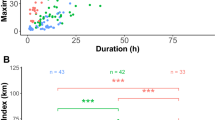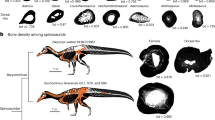This denizen of tropical swamps may shed light on how ancient fish were able to survive out of water.
Abstract
An important step towards understanding the evolution of terrestriality in vertebrates is to identify how the aquatic ancestors of tetrapods were able to access ground-based prey. We have discovered that the ‘eel catfish’ Channallabes apus, an inhabitant of the muddy swamps of tropical Africa, has a remarkable ability to forage and capture prey on land. The animal's capacity to bend its head down towards the ground while feeding seems to be an essential feature that may have enabled fish to make the transition from an aquatic to a terrestrial mode.
Similar content being viewed by others
Main
The acquisition of a terrestrial lifestyle, one of the key events in the evolution of vertebrates1, made vastly different physical demands from a life in water2. Early tetrapods were confronted with serious constraints on terrestrial foraging because aquatic vertebrates typically suck up their prey, using a rapid rostro–caudal expansion of the mouth cavity3,4. Air is about 800 times less dense than water, so a suction-induced flow will not move prey on land2. Early tetrapods were thus forced to develop alternative strategies for capturing their prey.
We discovered that eel catfish, despite being typical suction feeders in water, also capture food on land: the natural diet of this species consists mainly of terrestrial insects5. Our observations reveal that, after propelling its head on to the shore, the eel catfish lifts the front part of its body and bends its head downwards. Once the animal makes contact with its prey, the mouth opens and closes repeatedly until the object is held firmly between the jaws (for movie, see supplementary information).
The eel catfish preserves the rostro–caudal expansion wave (mouth opening, followed by extensive hyoid depression) during terrestrial feeding (Fig. 1). The resulting flow of air does not usually transport prey, but it may help when feeding on large, soft items (for movie, see supplementary information). In any case, it seems that prey can be caught on land with relatively minor changes in the higher-level control circuits that guide food capture.
a, Average, time-scaled kinematic profiles of the gape angle (red) and hyoid depression (green) in catfish capturing land-based prey (solid lines) compared with catfish bottom-feeding in water (dashed lines). Time value of 100% corresponds to maximal hyoid depression (see supplementary information). Note that the timing and range of mouth opening and hyoid depression are similar in both environments, resulting in a rostro–caudal sequence of head expansion. b, Measurement of gape angle (red) and hyoid depression (green). c, Posture of the skull and anterior part of the vertebral column during terrestrial feeding. d, High-speed-video frame of C. apus capturing a beetle on land. The inclination of the head towards the substrate is much steeper during terrestrial than during aquatic prey capture. Scale bars, 10 mm.
Bending the head ventrally, an action that is also observed in terrestrially feeding mudskippers6 (Periophthalminae), is essential because the prey might otherwise be pushed forwards and because the hyoid can be freely depressed in this position7. The posture calls for dorso–ventral flexion along the vertebral column. Recently discovered tetrapod-like fish8 and early tetrapods such as Ichthyostega9 show adaptations for such dorso–ventral flexion of the presacral vertebral column, and this may have allowed these animals to capture prey on land more effectively.
Our findings also show that having weight-bearing pectoral fins is not a prerequisite for capturing prey on land in a fish that has a flexible body. The importance of dorso–ventral flexion in the initial acquisition of a terrestrial feeding mode is further supported by the reduced number of presacral vertebrae that are found in tetrapod-like fish making the transition to tetrapods with weight-bearing pectoral fins8.
References
Ahlberg, P. E. & Milner, R. Nature 368, 507–514 (1994).
Bramble, D. M. & Wake, D. B. in Functional Vertebrate Morphology (eds Hildebrand, M. et al.) 230–261 (Belknap, Cambridge, Massachusetts, 1985).
Lauder, G. V. J. Morphol. 163, 283–317 (1985).
Summers, A. P. et al. J. Exp. Zool. 281, 280–287 (1998).
Huysentruyt, F. et al. Belg. J. Zool. 134, 25–30 (2004).
Sponder, D. L. & Lauder, G. V. J. Zool., Lond. 193, 517–530 (1981).
Van Wassenbergh, S. et al. J. Exp. Biol. 208, 4627–4638 (2005).
Daeschler, E. B., Shubin, N. H. & Jenkins, F. A. Jr Nature 757–763 (2006).
Ahlberg, P. E. et al. Nature 437, 137–140 (2005).
Author information
Authors and Affiliations
Corresponding author
Supplementary information
Supplementary information
(PDF 71 kb)
Supplementary movie
The eel catfish, Channallabes apus, can propel itself from the water to capture prey. (MPG 1484 kb)
Supplementary movie
This high speed video shows an eel catfish eating a morsel of cod on land. (MPG 1544 kb)
Supplementary movie
The swallowing motion of the eel catfish. (MPG 728 kb)
Rights and permissions
About this article
Cite this article
Van Wassenbergh, S., Herrel, A., Adriaens, D. et al. A catfish that can strike its prey on land. Nature 440, 881 (2006). https://doi.org/10.1038/440881a
Published:
Issue Date:
DOI: https://doi.org/10.1038/440881a
This article is cited by
-
Expanded olfactory system in ray-finned fishes capable of terrestrial exploration
BMC Biology (2023)
-
Fish uses 'water tongue' to grab prey on land
Nature (2015)
-
Flexibility is everything: prey capture throughout the seasonal habitat switches in the smooth newt Lissotriton vulgaris
Organisms Diversity & Evolution (2015)
-
The fish that hunts on land
Nature (2006)
Comments
By submitting a comment you agree to abide by our Terms and Community Guidelines. If you find something abusive or that does not comply with our terms or guidelines please flag it as inappropriate.




